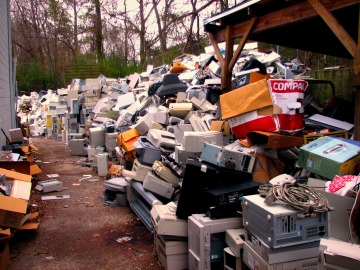Most of us only see the benefits we get from a robust and progressive digital world. We enjoy the perks of getting connected to the world on a global scale. From social media platforms, online shopping, convenient data transfer/ storage, and the sheer convenience and easy life afforded by technology to us, it is easy to turn a blind eye to the environmental destruction caused by too much technology in the planet.
 Not only do we use countless chemicals and toxic materials in the production of technological gadgets like computers, laptops, smartphones, and tablets, the manufacturing process itself may be harmful to the environment. Think of toxic batteries, chargers, and old units piling up somewhere. Then, there are the hazards posed by home and electrical appliances – both unused and scraps. Millions use these gadgets by now and understanding the severity regarding its disposal is something we should all take part in.
Not only do we use countless chemicals and toxic materials in the production of technological gadgets like computers, laptops, smartphones, and tablets, the manufacturing process itself may be harmful to the environment. Think of toxic batteries, chargers, and old units piling up somewhere. Then, there are the hazards posed by home and electrical appliances – both unused and scraps. Millions use these gadgets by now and understanding the severity regarding its disposal is something we should all take part in.
E-waste is an emerging issue, driven by the rapidly increasing quantities of complex end-of-life electronic equipment. The global level of production, consumption and recycling induces large flows of both toxic and valuable substances.
Electronic waste or e-waste refers to broken and unwanted electrical or electronic devices peripherals such as computers, monitors, printers, batteries, mobile phones, televisions, lamps and others, which are destined for reuse, resale, salvage, recycling, or disposal. E-waste mismanagement and its toxicity can lead to adverse human health effects and environmental pollution if disposed of incorrectly as there are more than 1,000 different harmful materials in e-waste products.
(Via: http://www.bizcommunity.com/Article/196/356/159605.html)
What else consists of e-waste then? How big of a problem is it in America?
E-waste consists of unwanted or broken electronic or electrical devices, and peripherals such as smartphones, televisions, laptops, refrigerators, computers, printers and other electronic products. The ever-rising problem of e-waste is being solved with the use of electronic recycling. Most electronic products are made up of metals, which are recyclable. The dismantling and recycling of end-of-life electronic products promotes the conservation of undamaged natural resources. Moreover, electronic recycling helps in minimizing the air and water pollution that is common in the disposal and landfilling of e-waste. Electronic recycling consists of three main processes: collection, pre-processing, and end-processing. The overall electronic scrap market was valued at US$ 11.03 Bn in 2014.
And these growing piles of e-waste contaminate the planet in a scale that we can never comprehend – making the world less livable and more toxic for everyone living in it. The damage has been done and the future generations will suffer from the neglect and abuse we are guilty of doing right now.
When e-waste is disposed in landfills, these toxic substances contaminate the water and soil, resulting in health problems. Recycling e-waste minimizes its propensity to cause health and environmental hazards. The use of electronic products and household equipment is on the rise globally. Most of the resultant e-waste from discarded electronic and household equipment is disposed of in landfills or exported illegally across international borders. The hazardous effects of e-waste and stringent government regulations to prevent improper disposal make electronic scrap one of the fastest-growing recycling segments. Europe is the second largest producer of e-waste in the world. The European Union’s Waste Electrical and Electronic Equipment (WEEE) Directive focuses on maximizing the recycling and re-use of e-waste and minimizes the amount of it disposed in landfills. According to this legislation, every year a minimum of four kilograms of e-waste per capita of the national population should be collected and recycled. This requirement might surge to approximately 13 to 16 kilograms of e-waste per person per year.
(Via: http://www.digitaljournal.com/pr/3281057)
Even the little things you do in preserving the environment by the simple acts of reducing waste, reusing trash and recycling can have a big impact on the world.
More and more electronic gadgets are making their way to the wastelands, especially in Asia. Phones, computers and other appliances have led to 12.3 million tons of e-waste in five years.
A study by the United Nations University shows e-trash is often dumped illegally, causing environmental problems.
Tech products often contain lead and mercury, which are toxic to the environment. The process of burning the electronics can also cause health issues. It’s usually how landfills get rid of the clutter.
Austin Startup, ‘Renew Logic’ is trying to take a greener approach with the discarded tech equipment.
CEO Gary Stephens said the company sells some discarded electronics into second-hand items and properly recycles the rest.
(Via: http://www.kvue.com/tech/eco-friendly-austin-startup-turns-discarded-electronics-into-cash/420257523)
While we can’t stop technology from taking over the world, there is still something we can do when it comes to proper e-waste management. Nature is not designed to get rid of these modern wastes on its own. These e-wastes will still remain piled one on top of the other for years to come. They not only ruin the view but leak deadly chemicals and wastes that may be harmful to human health.
If you are concerned about the environment and the future of the succeeding generations, you will take these matters seriously as it will be hard for us to correct our mistakes once the damage has been done.
